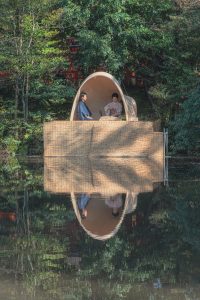Kuehn Malvezzi + Pelletier de Fontenay + Jodoin Lamarre Pratte architectes
The prestigious 2023 Grand Prix d’excellence en architecture from the Ordre des architectes du Québec was awarded to the Metamorphosis of the Montreal Insectarium, a project carried out by the consortium of Kuehn Malvezzi, Pelletier de Fontenay, and Jodoin Lamarre Pratte architects. The jury was particularly drawn to the immersive experience for the visitor, the synergy between architecture and landscape, and the technical challenges overcome to bring the museum concept to life.

Metamorphosis of the Montréal Insectarium — Main façade and Pollinator Garden
Photo credit:
James Brittain — Kuehn Malvezzi / Pelletier de Fontenay / Jodoin Lamarre Pratte architectes in consortium
The metamorphosis of the Montreal Insectarium redesigns our relationship with insects
Comprising the Biodôme, the Biosphère, the Insectarium, the Jardin botanique, and Planétarium Montreal, Space for Life is the largest nature science museum complex in Canada. It brings together a daring, creative urban movement, encouraging all of us to rethink the connection between humankind and nature in order to cultivate new ways of living. The new Insectarium, nestled alongside the Biodôme and the Jardin botanique, aims to transform the public's relationship with insects through an innovative architectural and museological approach.

Metamorphosis of the Montréal Insectarium — South façade
Photo credit: James Brittain — Kuehn Malvezzi / Pelletier de Fontenay / Jodoin Lamarre Pratte architectes in consortium

Metamorphosis of the Montréal Insectarium — Esplanade and Pollinator Garden
Photo credit: James Brittain — Kuehn Malvezzi / Pelletier de Fontenay / Jodoin Lamarre Pratte architectes in consortium
The design for the Insectarium was carried out by Berlin-based architects Kuehn Malvezzi and Montreal firms Pelletier de Fontenay and Jodoin Lamarre Pratte architectes, as well as landscape architects atelier le balto, Berlin. This partnership, completed with Montreal engineers Dupras Ledoux and NCK, won the international competition for the project in 2014 with a concept to fuse architecture and nature. Following a seven-year design and construction period, the Insectarium held its grand opening on April 13, 2022, revealing hundreds of insect species to the public. The new Insectarium replaces the city’s former Insectarium building, built in 1990, and features detailed displays for preserved insects and habitats for live species to thrive. At the heart of the project, there is an immersive sensory labyrinth experience, as well as a pollinator garden, creative workshops, and production areas.

Metamorphosis of the Montréal Insectarium — View on the Grand Vivarium from the Creative Workshop
Photo credit: James Brittain — Kuehn Malvezzi / Pelletier de Fontenay / Jodoin Lamarre Pratte architectes in consortium

Metamorphosis of the Montréal Insectarium — Grand Vivarium with free-living insects
Photo credit: James Brittain — Kuehn Malvezzi / Pelletier de Fontenay / Jodoin Lamarre Pratte architectes in consortium

Metamorphosis of the Montréal Insectarium — Laboratory
Photo credit: James Brittain — Kuehn Malvezzi / Pelletier de Fontenay / Jodoin Lamarre Pratte architectes in consortium
Architecture and nature
The design of the new Montreal Insectarium builds on detailed analysis of 400 years of museums, orangeries, greenhouses, and other architectures for the categorization and display of the natural world. Acknowledging the destructive history of this conceptual separation between humans and other natural life, the project’s design subverts museological norms and expectations. The external architecture of the Insectarium is visible through three archetypal structures that communicate a light touch construction process with integration into the pre-existing landscape of the botanical garden. The walled Pollinator Garden serves as a relaxing and welcoming space.Beyond the greenhouse, an enigmatic planted mound erupts from the surface as a cocoon-like dome that contains the Insectarium's collection within.

Metamorphosis of the Montréal Insectarium — Dome / Collection of naturalized specimens
Photo credit: James Brittain — Kuehn Malvezzi / Pelletier de Fontenay / Jodoin Lamarre Pratte architectes in consortium

Metamorphosis of the Montréal Insectarium — Dome / Collection of naturalized specimens
Photo credit: James Brittain — Kuehn Malvezzi / Pelletier de Fontenay / Jodoin Lamarre Pratte architectes in consortium
Immersive experience
Upon passing through the entrance hall, the immersive experience of sensory metamorphosis begins. The Labyrinth takes visitors through a curved, descending path with sloping walls. The path is designed to destabilize our perception; to signal a departure from familiar spatial environments and the entrance to an underground labyrinth of six Perceptual Alcoves.

Metamorphosis of the Montréal Insectarium — Grand Vivarium with view on the plant production
Photo credit: James Brittain — Kuehn Malvezzi / Pelletier de Fontenay / Jodoin Lamarre Pratte architectes in consortium

Metamorphosis of the Montréal Insectarium — Ramp to the Grand Vivarium
Photo credit: James Brittain — Kuehn Malvezzi / Pelletier de Fontenay / Jodoin Lamarre Pratte architectes in consortium
The six rooms disorient human senses and mimic the sight, sound, and movement of insect
- One eye, many facets simulates the pixelated vision of a fly.
- Good vibes amplifies the room’s vibrations to reflect the sonics of a grasshopper.
- From blade to blade is a route of climbable sticks, requiring the balance of a gnat atop a leaf.
- Tight squeeze turns humans into cockroaches who must negotiate a tight squeeze.
- The world in UV replicates the ultraviolet vision of a bee.
- Ceiling walk turns the world upside down.

Metamorphosis of the Montréal Insectarium — Alcove "One eye, many facets"
Photo credit: James Brittain — Kuehn Malvezzi / Pelletier de Fontenay / Jodoin Lamarre Pratte architectes in consortium

Metamorphosis of the Montréal Insectarium — Alcove "From blade to blade"
Photo credit: James Brittain — Kuehn Malvezzi / Pelletier de Fontenay / Jodoin Lamarre Pratte architectes in consortium

Metamorphosis of the Montréal Insectarium — Labyrinth
Photo credit: James Brittain — Kuehn Malvezzi / Pelletier de Fontenay / Jodoin Lamarre Pratte architectes in consortium

Metamorphosis of the Montréal Insectarium — Alcove "The world in UV"
Photo credit: James Brittain — Kuehn Malvezzi / Pelletier de Fontenay / Jodoin Lamarre Pratte architectes in consortium
Having experienced sensory experimentation in the six rooms, visitors finally meet living insects in the Tête-à-tête Gallery. Six bespoke viewing boxes in the space allow visitors to block out the exterior world, providing a close-up view of insects in different vivaria. The niches facilitate concentrated and immersive contact with the different species of insect; a contact that has been reformulated by the immersive perceptual spaces.
Interspecies encounters
Re-emerging from the earthen textures of the underground, visitors enter the Grand Vivarium. This spacious, light-filled greenhouse features a gradually inclining route that progresses through a range of micro-climates supporting the life of varying plant and insect species. Many of the insects, such as butterflies and caterpillars, move freely in the space and can be observed without barriers. Others, such as leaf-cutter ants, giant beetles, scorpions, and giant centipedes, are presented in glass vivaria integrated into the botanical landscape of the Grand Vivarium.

Metamorphosis of the Montréal Insectarium — Grand Vivarium with free-living insects
Photo credit: James Brittain — Kuehn Malvezzi / Pelletier de Fontenay / Jodoin Lamarre Pratte architectes in consortium

Metamorphosis of the Montréal Insectarium — Greenhouse for plant production
Photo credit: James Brittain — Kuehn Malvezzi / Pelletier de Fontenay / Jodoin Lamarre Pratte architectes in consortium
About Kuehn Malvezzi
Simona Malvezzi, Wilfried Kuehn, and Johannes Kuehn founded Kuehn Malvezzi in Berlin in 2001. Public spaces and museums are the main focus of their practice. Sustainability and building with an awareness of social contexts and nature are further focal points in their work.
About Pelletier de Fontenay
Established in 2010 by Hubert Pelletier and Yves de Fontenay, Pelletier de Fontenay is an architectural practice based in Montreal. The office has quickly gained a reputation for excellence in designing contemporary public buildings and is currently working on projects for museums, schools, and libraries.
About Jodoin Lamarre Pratte architectes
Jodoin Lamarre Pratte architectes devotes its practice to the design of architectural projects for the community —mainly in the institutional fields of healthcare, transportation, education, research, and culture— as well as the realization of large corporate and governmental projects. The firm works towards the conception of a human, sensitive, intelligent architecture that respects its environment, combining creativity, knowledge, and innovation. It values the diversity and complementarity of the skills and expertise of the members of its large team, while perpetuating a culture of collaboration, inclusion, integrity, and thoroughness.
About atelier le balto
Created in Berlin in 2001, the team of atelier le balto is composed of four landscape-architects who also have an education in gardening. Considering the art of gardens in the same way as painting or choreography, they insist on the fact that a garden is not a fixed image. In their works, if the architectural design is particularly present in winter, a certain exuberance expands throughout the summer. The further development of the garden by a professional gardener is then essential.

 English
English 日本語
日本語
